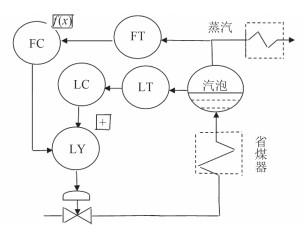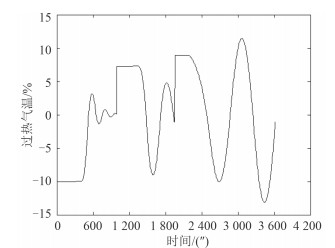船舶增压锅炉系统为船舶的动力系统提供主要的动力来源,稳定性和安全性一直都是该系统的首要要求,因此其对控制系统安全性提出了相当高的要求。只有稳定性好、抗干扰能力强的主控系统,才能在未来的复杂航线环境中取得优势[1-3]。而在增压锅炉的控制系统中,对汽包水位和温度的控制一直是个难点。因此本文重点研究了锅炉系统的非线性特征,建立了汽包状态模型,结合神经控制算法对汽包的状态预测技术进行了深入研究。
1 船舶锅炉汽包状态模型在锅炉汽包控制中,首先是对锅炉的供水量进行控制,然后根据水温对蒸汽进行监测,这一过程被称作导前区,而把水汽变成蒸汽的过程称作惰性区,因此可以建立基于锅炉主气温的动态状态特性方程:
| ${G_0} = \frac{{{\theta _1}\left( s \right)}}{{W\left( s \right)}} = \frac{{{k_0}}}{{{{\left( {1 + {T_0}s} \right)}^n}}}\text{,}$ | (1) |
式中:k0为与锅炉系统相关的放大系数,T0为系统的参考时间常数,n为阶次。
可以推断出导前区的状态传递函数为:
| ${G_1} = \frac{{{\theta _2}\left( s \right)}}{{W\left( s \right)}} = \frac{{{k_2}}}{{{{\left( {1 + {T_2}s} \right)}^{{n_2}}}}}\text{,}$ | (2) |
式中:k2为导前区放大系数,T2为参考时间常数,n2为系统阶次。
同理,锅炉系统惰性区传递函数为
| ${G_2} = \frac{{{\theta _1}\left( s \right)}}{{2\left( s \right)}} = \frac{{{k_1}}}{{{{\left( {1 + {T_1}s} \right)}^{{n_1}}}}}\text{,}$ | (3) |
式中:k1为惰性区的放大系数,T1为时间常数,n1为系统的阶次。此区的传递函数需要通过下面方程得到
| ${G_2}\left( s \right) = \frac{{{G_0}\left( s \right)}}{{{G_1}\left( s \right)}}\text{,}$ | (4) |
综上可得
| ${k_1} = \frac{{{k_0}}}{{{k_2}}}\text{,}$ | (5) |
| ${T_1} = \frac{{{n_0}{T_0}^2 - {n_2}{T_2}^2}}{{{n_0}{T_0} - {n_2}{T_2}}}\text{,}$ | (6) |
汽包水位的动态特性,误差函数近似方程为:
| $\frac{{H(s)}}{{W(s)}} = \frac{{{k_0}}}{S}{e^{ - \tau s}}\text{。}$ | (7) |
锅炉汽包水位的控制模型如图 1所示,该系统主要由锅炉蒸汽室、节能装置和反馈控制系统构成。

|
图 1 汽包水位控制模型 Fig. 1 Water level control model of drum |
该神经网络算法的特点是以径向基函数作为主要的单隐层前向网络函数,因此该函数中的隐含单元函数的权值需要后期通过学习确定,在网络隐含层中选择不同的径向基函数来满足不同的应用需求。所以,在实际应用中,RBF神经网络算法能够良好适应非线性适应系统[4-6]。
设定汽包状态的非线性映射为:
| ${f_r}(X) = {W_0} + \sum\limits_{i = 1}^{{n_r}} {{W_i} \cdot \varphi (\left\| {X - {C_i}} \right\|} )\text{,}$ | (8) |
式中,
| $\varphi \left( v \right) = \exp ( - {\left\| {X - {C_i}} \right\|^2})\text{,}$ | (9) |
在非线性映射式中,
神经网络的中间网络节点输出函数为:
| ${Z_i} = \varphi (\left\| {X - {C_i}} \right\|/{\sigma _i})\text{,}$ | (10) |
式中
所以在RBF神经网络系统中需要确定3种重要参量:
1)神经网络的权值Wi ;
2)基函数的中心矢量Ci
3)网络总的中心数目nr 。
若由Θ表示上述3种参量,则在锅炉汽包系统样本
| $\varepsilon _{RBF}^2({D_N},\mathop \Theta \limits^ \wedge ) = \min \varepsilon _{RBF}^2[{D_N},f(X,\Theta )]\text{。}$ | (11) |
在汽包水位状态动态控制系统中,PID控制式为
| $u\left( t \right) = {k_p}\left( {e\left( t \right) + \frac{1}{{{T_i}}}\int_0^t {e\left( t \right)} {\rm{d}}t + \frac{{{T_d}{\rm{d}}e\left( t \right)}}{{{\rm{d}}t}}} \right)\text{,}$ | (12) |
式中,kp表示系统的比例系数,Ti 表示系统积分时间常量,Td 为微分计算的时间常量。
构建具体的传递函数
| $G\left( s \right) = \frac{{U\left( s \right)}}{{E\left( s \right)}} = kp\left( {1 + \frac{1}{{{T_i}s}} + {T_d}s} \right)\text{。}$ | (13) |
通过设定较小的时钟采样周期,并进行基本的积分和微分操作,得到如下的离散控制函数:
| $\left\{ \begin{array}{l} t = kT\text{,}\\ \int_0^t {e\left( t \right)} \approx T\;\;\sum\limits_{j = 0}^k {e\left( j \right)} \text{,}\\ \frac{{{\rm{d}}e\left( t \right)}}{{{\rm{d}}t}} \approx \frac{{e\left( k \right) - e\left( {k - 1} \right)}}{T}\text{。} \end{array} \right.$ | (14) |
由上面的推导,可以建立主锅炉的蒸汽动态系统模型,设导前区的模型为:
当系统的负荷设定为80%时,导前区方程为:

|
图 2 汽包状态变化曲线 Fig. 2 Drum state change curve |
在该负荷条件下,锅炉在前500 s内启动相对稳定,整个启动过程的温度和水位变化不大,随着时间的加长,为了能够保证锅炉系统的稳定性,需要保证整个温度和水位的变化维持在10%的波动范围内。从图 2中可以发现3 000 s以后,控制系统能够维持在相对稳定的范围内。
3 结语船舶锅炉系统的发展已经从以前的人工控制升级为现在的智能化控制,其安全性能也更加强大,本文提出的基于神经网络算法的汽包预测控制系统,具有良好的鲁棒性和稳定性,符合未来控制系统的发展趋势。
| [1] | 吴健, 赵德光, 张志杰. 基于神经网络的传感器动态补偿算法及DSP实现[J]. 计算机测量与控制, 2011 (5): 1239–1241, 1245. |
| [2] | 唐令波, 雷玉勇, 邴龙健, 等. 基于模糊PID的工业锅炉汽包水位控制系统的仿真研究[J]. 机械设计与制造, 2009 (11): 110–112. |
| [3] | 俞阿龙, 黄惟一. 基于改进遗传神经网络的微硅加速度传感器动态补偿研究[J]. 东南大学学报(自然科学版), 2004 (4): 455–458. |
| [4] | MOHAMMADZADEH S, ZARGARI H, GHAYYEM M A. The application of intelligent computation (artificial neural network-ANN) prediction of sweet gas concentration in a gas absorption column[J]. Energy Sources Part A Recovery Utilization & Environmental Effects, 2015, 37 (5): 485–493. |
| [5] | DAS K P, GANGULY S, CHATTOPADHYAY P P, et al. Exploring the possibilities of development of directly quenched TRIP-aided steel by the artificial neural networks (ANN) technique[J]. Advanced Manufacturing Processes, 2009, 24 (1): 68–77. DOI: 10.1080/10426910802543723 |
| [6] | SALMASI F, YıLDıRıM G, MASOODI A, et al. Predicting discharge coefficient of compound broad-crested weir by using genetic programming (GP) and artificial neural network (ANN) techniques[J]. Arabian Journal of Geosciences, 2013, 6 (7): 2709–2717. DOI: 10.1007/s12517-012-0540-7 |
 2017, Vol. 39
2017, Vol. 39
